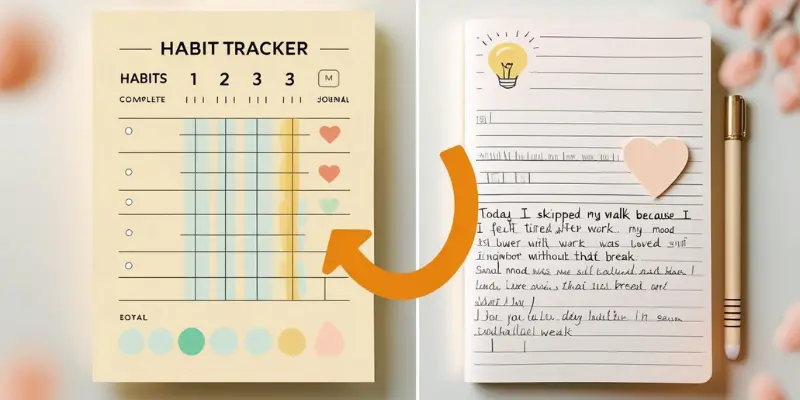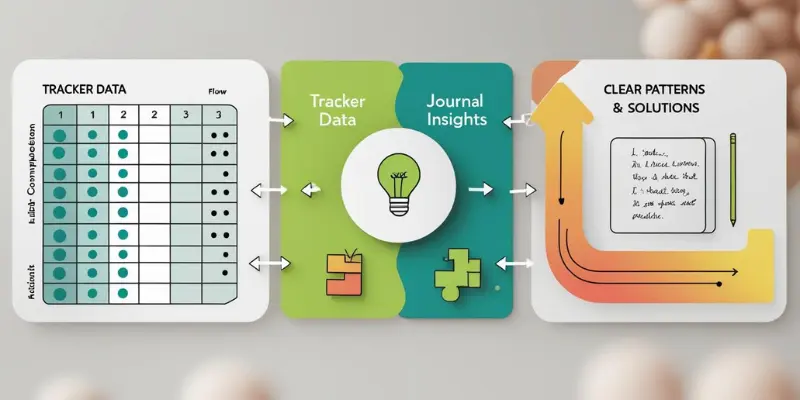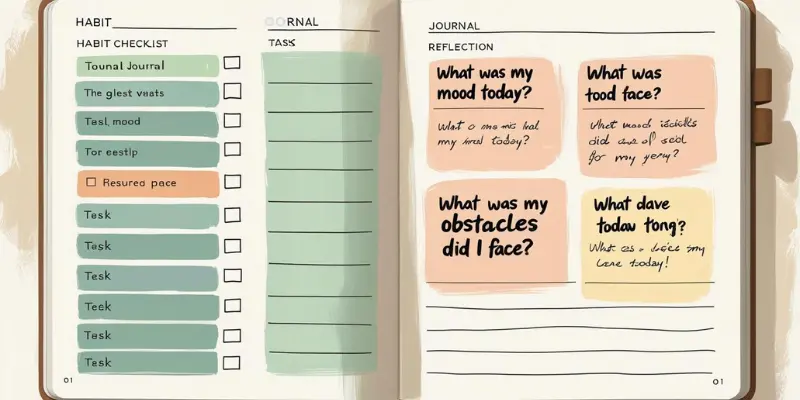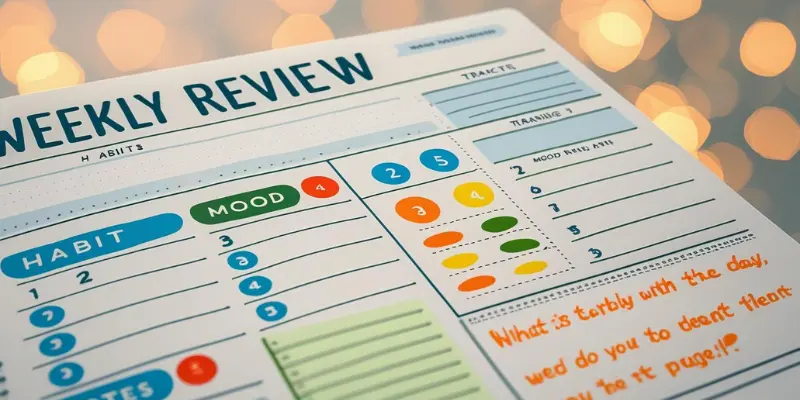The Ultimate Guide: How to Combine a Habit Tracker and Journal for Deeper Self-Awareness and Lasting Change
Published: 09/08/2025
If you’ve ever started a habit tracker with the best intentions, only to stop using it after a few days, you’re not alone.
Maybe you set up a colorful spreadsheet or downloaded a sleek app, but the excitement faded and it became just another chore.
Or perhaps you bought a beautiful journal, determined to write in it every day — and now it’s sitting on your desk, half-filled, silently reminding you that you “failed” again.
The truth? The problem isn’t you. It’s the system you’ve been given.
Most habit trackers and journals are treated as two completely separate tools:
- A tracker tells you what you did, but never why you did it — or why you didn’t.
- A journal captures how you felt, but rarely connects those feelings to your daily actions.
Without that connection, you’re left with two half-finished puzzles. You can see pieces of your life, but not the full picture.
What you really need is a simple way to link the two — to track your actions and reflect on them in the same flow. That’s what this guide is all about. I’ll walk you through a system that’s easy to keep up with, makes sense of your habits, and helps you build meaningful change that lasts.

The “Why” — Connecting Your Habits to Your Inner World
Before diving into how to improve your habit tracking, it’s important to understand why the usual methods often fall short. Recognizing these common pitfalls will help you see why a deeper approach—one that links your actions to your inner experiences—is key to making real progress.
Why the Old Way Fails
If you’ve ever used a habit tracker before, you know the routine: open the app or notebook, check a box, and move on. It’s quick and satisfying in the moment — but that’s all it tells you.
You see the result (“I did it” or “I didn’t”), but you don’t see the story behind it.
- Why did you skip your run on Tuesday?
- Why did journaling feel easy last week but impossible this week?
- What was happening in your head and heart before you made that choice?
Without this layer of understanding, you’re collecting numbers without meaning. And when habits start slipping, you don’t have the insight you need to fix the problem — so it’s easier to give up altogether.
The Power of the Combined Approach
When you bring a habit tracker and a journal together, you create something far more powerful than either tool on its own. You start to see the full picture:
- External data: The habits you completed (or skipped).
- Internal insight: The thoughts, emotions, and circumstances that shaped your choices.
This combination transforms your system from a checklist into a feedback loop. You’re not just tracking — you’re learning about yourself in real time.
You might notice patterns like:
- “Every time I drink enough water before lunch, I have more energy in the afternoon.”
- “On days I skip my walk, I’m twice as likely to end the evening stressed.”
Personal Note: When I used a tracker alone, I could see I was missing workouts — but the data was useless without context. When I started adding short daily reflections, I noticed a clear pattern: I skipped workouts on days packed with back-to-back meetings. That simple realization helped me move my workouts to mornings, and I stopped missing them.

The Core Framework — A Simple 3-Step Process
Now that we understand why simply tracking habits isn’t enough, let’s look at a straightforward framework that helps you build awareness and make meaningful changes—without feeling overwhelmed.
Step 1: Track with Intention
Trying to change everything at once is a quick path to burnout. Instead, focus on 1 to 3 habits that truly matter to you right now. This keeps things manageable and lets you give each habit the attention it deserves.
Before you start tracking, get clear on why you want to build these habits. Ask yourself:
- “What positive change will this habit bring to my life?”
- “How will I feel if I stick with this for a whole year?”
When you have a clear purpose, it’s easier to stay motivated—even on days when the habit feels tough.
Step 2: Observe & Reflect Daily
Right after you check off your habit (or note that you didn’t), take a moment to open your journal. Answer one or two simple questions, like:
- “What was my mood today after completing this habit?”
- “What obstacles got in my way?”
- “How did I feel when I skipped this habit?”
This small daily habit turns your journal from a random log into a tool that uncovers meaning behind your actions. It helps you notice patterns in your feelings and behavior, turning simple tracking into thoughtful self-awareness.

Step 3: Analyze & Adjust Weekly
Set aside 10 minutes each week to review your habit tracker and journal together. Look closely for patterns, such as:
- Which habits consistently lift your mood?
- Are there specific times or situations when you tend to skip a habit?
- Do your energy levels change on certain days or after certain activities?
This weekly check-in is where the real progress happens. Instead of just reacting to slip-ups, you start understanding why they happen—and you can make small, smart adjustments to keep moving forward.
For example, if you notice you skip your evening walk on busy days, try moving it to the morning when you have more energy.
This step shifts you from feeling stuck to feeling in control—your habits become a conversation, not a chore.

Analog vs. Digital — Which Tools Are Right for You?
Choosing the right tools can make a big difference in how easily you stick with your habit and journaling system. Let’s explore the strengths of both analog and digital options so you can find what fits your style and lifestyle best.
The Best of Analog
There’s something grounding about putting pen to paper. For many, writing by hand feels more personal and less distracting than tapping on a screen. If you like a tactile, focused experience, analog tools might be your best fit.
Here are some popular analog options:
- Themed Journals: These come pre-designed for wellness, gratitude, or habit tracking, so you don’t have to start from scratch.
- Customizable Systems: The Bullet Journal is a great example—it lets you build exactly what you need with complete freedom.
- All-in-One Planners: These combine calendars, habit trackers, and space for notes, giving you a single place for everything.
The Best of Digital
Digital tools offer convenience and automation that paper can’t match. With reminders, syncing across devices, and built-in analytics, they make tracking easier and sometimes more motivating.
Some top digital options include:
- Integrated Apps: Notion, Todoist, and Evernote combine task management with note-taking and tracking.
- Gamified Trackers: Habitica turns habits into a game, making motivation fun.
- Minimalist Trackers: Apps like Loop or Streaks focus purely on simple habit tracking with minimal distractions.
The Hybrid Approach
You don’t have to pick just one. Many people find success by combining both:
- Use a digital habit tracker for timely reminders and data collection.
- Use a paper journal for reflection, deeper insights, and emotional connection.
Here’s a quick look at how analog and digital tools compare:
| Feature | Analog | Digital |
|---|---|---|
| Distraction-free | ✅ Focused, no notifications | ❌ Risk of getting sidetracked by other apps |
| Analytics | ❌ Manual review required | ✅ Automated stats and trends |
| Portability | Medium — depends on your journal | ✅ Access anytime on your phone or computer |
| Emotional depth | ✅ Writing by hand connects feelings | ✅ Possible if you journal thoughtfully |
Expert Tips & Common Mistakes to Avoid
Before we dive into common pitfalls, it’s helpful to know that even small adjustments can make a big difference. Recognizing these frequent mistakes early can save you time and frustration on your journey.
Mistake #1: Over-tracking
It’s tempting to tackle a dozen habits at once, thinking more is better. But piling on too many habits quickly leads to overwhelm and burnout. When everything feels like a chore, motivation drops — and giving up feels easier than pushing through.
Tip: Start small. Pick just one habit and commit to it for 30 days. Once it becomes a natural part of your routine, add another. This slow build keeps your focus sharp and your progress steady.
Mistake #2: The “Perfect Page” Trap
If you’ve ever scrolled through perfectly styled journals on Instagram and felt your own pages don’t measure up, you’re not alone. Perfectionism can stop you from writing at all.
Tip: Your journal isn’t for anyone else — it’s for you. Focus on progress, not pretty. Scribbles, messy handwriting, or simple bullet points are all fine if they help you keep going.
Mistake #3: Ignoring the Data
Tracking without reflection turns your system into a chore. When you don’t review what you’ve recorded, you miss the chance to learn from your habits and feelings.
Tip: Schedule a quick 10-minute weekly review. Look for patterns, celebrate wins, and make small adjustments. This habit of reflection turns tracking from busywork into meaningful growth.
Conclusion: Your Journey Starts Now
Combining a habit tracker with a journal is more than just checking boxes — it turns you into someone who truly understands yourself. This simple system connects your daily actions with your feelings, making change personal and something you can keep up with over time.
Start today by picking one habit that matters to you. Choose a journal or an app that feels right. Make a promise to yourself to reflect each day, even if it’s just a sentence or two.
As you build this practice, you’ll notice something powerful: awareness becomes action. You’ll know not just what you’re doing, but why it matters. That’s the real key to lasting change.
Your turn: After your first week, drop a comment below sharing one insight you’ve gained from combining your habit tracker and journal. I’m excited to hear your experience.
Have More Questions? Let’s Get You an Answer
Combining both helps you see not just what you did, but why you did it. This deeper insight makes habits easier to understand and change.
Start with 1 to 3 habits to avoid overwhelm. Focusing on a few helps build consistency and makes reflection manageable.
Yes! Choose whatever feels easiest and most enjoyable for you—whether that’s a simple notebook or a digital app.
Missing a day is normal. The goal is progress, not perfection. Reflect on why it happened and get back on track without judgment
Many notice changes in self-awareness within a week, but lasting habits usually take at least 30 days of consistent practice
Simple prompts about mood, obstacles, and feelings right after your habit help you connect your actions to your emotions.
Track daily, but set aside 10 minutes weekly to review patterns and adjust your habits accordingly.

- Be Respectful
- Stay Relevant
- Stay Positive
- True Feedback
- Encourage Discussion
- Avoid Spamming
- No Fake News
- Don't Copy-Paste
- No Personal Attacks



- Be Respectful
- Stay Relevant
- Stay Positive
- True Feedback
- Encourage Discussion
- Avoid Spamming
- No Fake News
- Don't Copy-Paste
- No Personal Attacks





